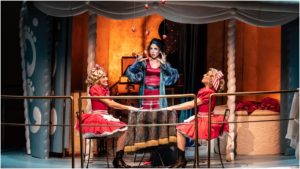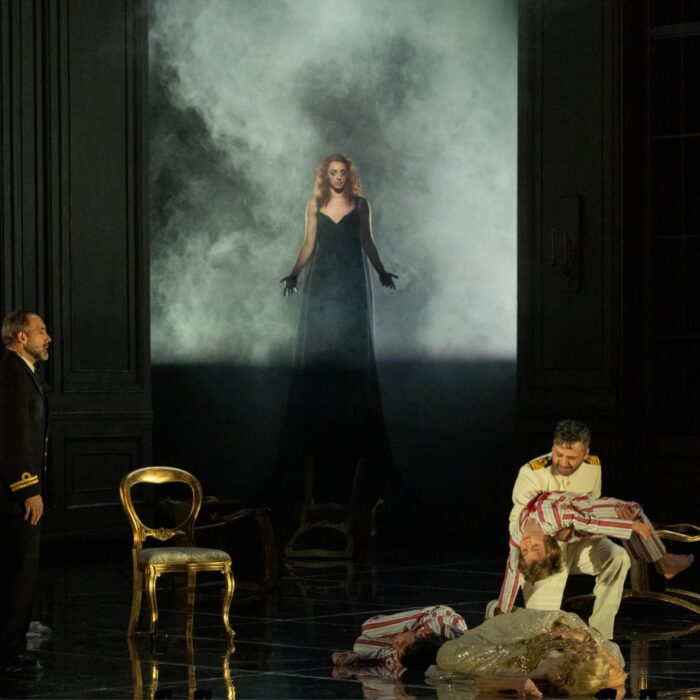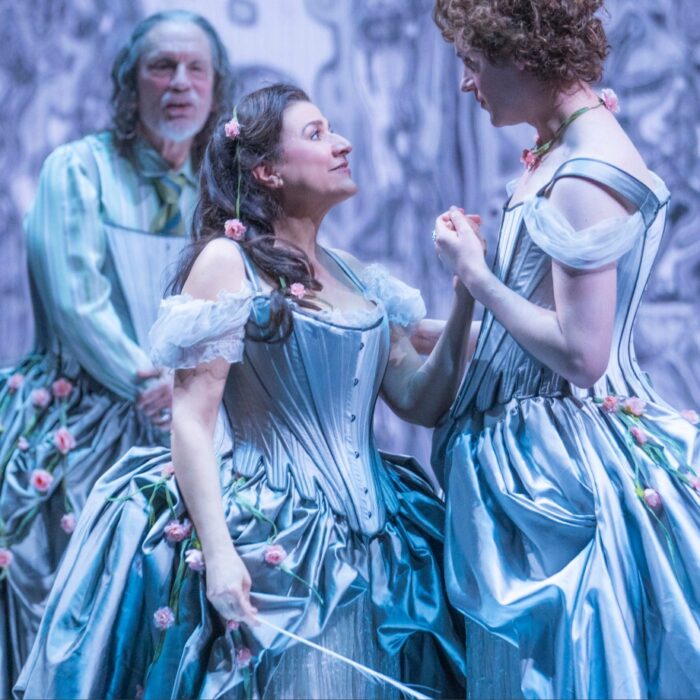
Wexford Festival Opera 2019 Review: La Cucina & Adina
A Light Hors D’Oeuvre Followed By A Delicious Dessert Starring Levy Sekgapane & Rachel Kelly
By Alan Neilson(Photos: Clive Barda)
With a running time of about one hour 20 minutes, Rossini’s “Adina” is a little too short to justify presenting on its own, especially if the intention is to charge full ticket prices.
But then, if it is going to be staged as part of a double bill, the question arises, with what? It is not as easy to answer as may first appear, for there must be some coherence between the two works, either in the way of development, contrast or complementary themes. With a Rossini opera this would appear to be a particularly difficult task; another work by Rossini would be self-defeating, a comedy by another composer is likely to be left in the shadow of Rossini’s genius, whilst a heavier work may cause the audience to feel a bit dislocated.
Wexford’s imaginative solution was to commission a new work by Andrew Synnott, whose chamber opera, “The Dubliners” for the festival in 2017 proved to be such a success. The librettist for this new work was the festival’s new Artistic Director as of 2020, Rosetta Cucchi, who was also the director for this double bill.
La Cucina
Their solution was to write a short work set in a commercial kitchen, lasting around 40 minutes, which linked in cleverly with the production of “Adina,” which had a large wedding cake as its dominating feature.
“La Cucina” has a light, frivolous narrative of little consequence, which amuses, and contains occasional slapstick interludes, but could not be classed as “rolling in the aisles” comedy. There is no attempt to compete with Rossini.
Playing upon the media’s current obsession with anything do with cooking and egotistical chefs, in which the ritual humiliation of their staff or contestants is seen as great entertainment rather than the boorish, unacceptable trash it actually is, the opera focuses on a talented chef, called Alberto, who owing to a traumatic event some years ago, can no longer speak, although this does not stop him from abusing and even physically attacking his new trainee Camillo. Alberto is attempting to recreate a great recipe, but his chefs do not appear to be up to the task which increases his frustrations, and leads to some moments of mildly amusing confusion. Eventually, he realises his error, that his talented staff are more important than a missing ingredient and all are reunited, before he moves on to seek new adventures.
Synnott’s music was tonal and distinctly 20th century in style with hints of Puccini, Britten, and others interwoven into the score. It was lively and fairly fast-moving, but not one-paced, and allowed for contrasts and changes of mood. Michele Spotti, conducting the Orchestra of Wexford Festival Opera, elicited a well-balanced performance, cognizant of its dramatic function and sympathetic to the singers needs.
The cast consisted of four singers: Alberto’s assistant Bianca and her trainee Camillo and two delivery men, Zeno and Tobia, who between them involve themselves in a great deal chaos and arguing, caused by the stresses and frustrations of working for the genius, Alberto.
Soprano Máire Flavin, in the role of Bianca, sang well, producing a spirited performance in which her bright upper registered shone fiercely as her temper occasionally flared. It was an impassioned and very human portrait, supportive of Camillo, but also of her boss Alberto, but with whom she she eventually loses patiences.
Camillo was essayed by baritone, Emmanuel Franco, who gave an equally strong performance, in which his warm, attractive timbre and finely crafted phrasing impressed.
Zeno and Tobia were played by baritone, Sheldon Baxter and tenor, Manuel Amati. Both produced solid performances. Baxter acted out the part energetically, his singing was agile and clear. Amati possesses an engaging stage presence with an appealing vocal timbre.
The silent role of Alberto was played by Luca Necera, who produced a strongly defined and lively portrayal, and despite not speaking until the very end, was able to use his fine array of facial gestures and exaggerated movements to communicate with his chefs, and relate clearly to the audience. As he leaves he dons a green colored top hat, reappearing later in the Alice in Wonderland set of “Adina.”
The set designed by Tiziano Santi was simple, but functional, comprising a simple commercial kitchen. Costumes by Claudia Pernigotti were likewise functional and typical for their roles. The one exception being the flamboyant and colourful costume of Alberto, which cleverly highlighted his role, his status and character. Cucchi’s direction ensured a vibrant and lively presentation with plenty of movement and did her best to bring out the comedic aspects of the piece.
The work ends with a quote from Rossini, “eating, loving, singing and digesting are the four acts of the comic opera known as life.” The parts of a three-tiered, blue and white cake are taken from the fridge and assembled on the table, which is, in fact, the same wedding cake which forms the centre piece for “Adina”, inside of which the characters live. The piece thus slides smoothly from the world of the angst-riven kitchen into Rossini and Cucchi’s comedic fantasy world.
Adina
“Adina” is certainly not one of Rossini’s better known works, nor is it one of his more accomplished. In fact, Rossini did not give much consideration to its construction, borrowing music from his earlier opera “Sigismondo,” as well as using music from other composers. Having written it as a commission for Diego Ignazio de Pina Manique, the Superintendent of Theatres in Lisbon in 1818, it remained unperformed until 1826, and there is no evidence that Rossini ever saw it performed.
The story is typical of the farsa genre, with the Caliph wanting to marry Adina, who although she has strong feelings towards him, prefers Selimo, who attempts to abduct her from the harem, but they are caught trying to escape. Everything turns out well, however, when it is discovered that Adina is actually the Caliph’s daughter, which explains their feelings for each other, and she is free to marry Selimo.
Cucchi’s approach to the work was inspired by the whimsical worlds of such films as Tim Burton’s “Alice in Wonderland” and Wes Anderson’s “The Grand Budapest Hotel” in which, with a lot of good luck and a hint of magic, the impossible becomes possible. Hence, we enter into a make believe world in which Adina lives on the upper and middle levels of a three-tiered cake, while the bottom tier is the Caliph’s palace.
The light blue icing with its sugary white trimmings, designed by Tiziano Santi, capture Cucchi’s vision perfectly. There is little of the melancholia contained within the original text, rather everything is sugary, fun and fizzy. Nothing is taken too seriously. The costumes, designed by Claudia Pernigotti, are colorful, flamboyant and occasionally fantastical, adding a further dash of magic to the performance. And it all worked so well, bringing life and energy to what is not the best of stories.
Rachel Kelly, cast in title role of Adina, had a tough task in having to follow Lisette Oropesa who performed the role in its original production at last year’s Rossini Festival in Pesaro, but she did herself proud, putting in an excellent performance full of energy and fizz. Displaying versatility and beauty, her vocal performance was wonderfully expressive and captured the spirit of the presentation, her coloratura dazzled, her trilling was spot on and she managed to hit a top C sharp, all of which was supported by some fine acting, and all done with a humorous air.
As the farsa moves towards its end, believing Selimo to have been killed, Kelly engages in a bit of over the top raging, much to the amusement of the onlookers, who all know he is alive and well, in a brilliantly directed and delivered scene.
Her Selimo was played by the equally accomplished Levy Sekgapane, who employed his light tenor with strength and versatility. He made for an engaging Selimo, clothing his lines with an attractive tone. His voice is bright and wonderfully secure, and hits the top notes with apparent ease and surety, in what was an expressive and attractive reading.
The bass-baritone, Daniele Antonangeli, was parted as the Caliph, and cast an authoritative and severe presence over proceedings, but which few took much notice off, as his guards chased around the stage with toy guns and the chefs continued icing the cake, amongst a lot of other goings-on. His singing was warm, clear and agile.
The Caliph’s trusted friend, Ali, was played by Manuel Amati, who showed off his tenor in fine style. He possesses a sweet sounding voice, which is securely founded, although he needs to improve his projection if he wishes to reach his full potential, which is certainly significant.
Emmanuel Franco, building upon his role as Camillo in “La Cucina,” produced another good performance in the part of Mustafa.
Michele Spotti produced another excellent performance from the Orchestra of Wexford Festival Opera, capturing the vibrancy of the onstage shenanigans in the music, and eliciting some beautiful playing from the strings and woodwind.
Overall, It proved to be a successful combination in which the two works complemented each other nicely, although exactly where “La Cucina goes from here is difficult to say; its strength comes from the relationship it has with “Adina;” a light hors d’oeuvre before the main dish, so to speak. For sure, it is pleasant enough in its own right, but it is difficult to see how it will be able to hold the stage if separated from “Adina,” and it is certainly not of the same quality as Synnott’s earlier opera “The Dubliners.”
On the other hand, this production of “Adina” suggest that with an imaginative staging it has the potential for productions on a more regular basis.



